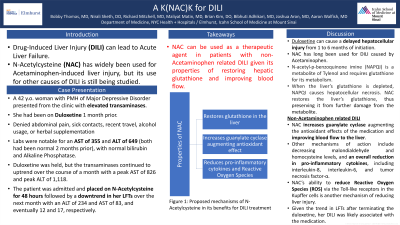Sunday Poster Session
Category: Liver
P1373 - A K(NAC)K for DILI
Sunday, October 27, 2024
3:30 PM - 7:00 PM ET
Location: Exhibit Hall E

Has Audio

Bobby Thomas, MD
Elmhurst Hospital Center / Icahn School of Medicine at Mount Sinai
New York, NY
Presenting Author(s)
Bobby Thomas, MD1, Nirali Sheth, MD2, Richard Mitchell, MD3, Maliyat Matin, MD3, Woo Suk Kim, DO3, Bibhuti Adhikari, MD3, Joshua Aron, MD2, Aaron Walfish, MD3
1Elmhurst Hospital Center / Icahn School of Medicine at Mount Sinai, New York, NY; 2Elmhurst Hospital Center / Icahn School of Medicine at Mount Sinai, Elmhurst, NY; 3Elmhurst Hospital Center / Icahn School of Medicine at Mount Sinai, Queens, NY
Introduction: Drug Induced Liver Injury (DILI) is serious complication that can lead to Acute Liver Failure (ALF). Acetaminophen is a common cause of DILI due to the depletion of glutathione leading to hepatocellular injury. N-Acetylcysteine (NAC) has widely been used for Acetaminophen Induced Liver Injury, but it’s utility for other causes of DILI are still being discovered, opening up other possibilities for treatment of patients with ALF.
Case Description/Methods: A 42 year old female with a past medical history of major depressive disorder presented with elevated Liver Function Tests (LFTs) after starting duloxetine one month ago. She denied abdominal pain, sick contacts, recent travel, alcohol usage, or herbal supplementation. During this time, her LFTs increased over the course of the month from normal levels to an ALT of 649 and AST of 355. Her total bilirubin and Alkaline Phosphatase were normal. Duloxetine was held, but there was still an uptrend in her LFTs over the course of a month. The patient was then placed on N-Acetylcysteine for 48 hours followed by a down trend in her LFTs with an ALT of 234 and AST of 83, and eventually 12 and 17, respectively.
Discussion: NAC has long been used as a treatment for DILI caused by Acetaminophen. N-acetyl-p-benzoquinone imine (NAPQI) is a metabolite of Tylenol and requires glutathione for its metabolism, but when the liver’s glutathione is depleted, NAPQI causes hepatocellular necrosis. NAC restores the liver’s glutathione, thus preserving it from further damage from the metabolite. NAC increases guanylate cyclase increasing the antioxidant effects of the medication and improving blood flow to the liver. Other mechanisms of action include decreasing malondialdehyde and homocysteine levels, and an overall reduction in pro-inflammatory cytokines, including interleukin-8, interleukin-6, and tumor necrosis factor-α. Reducing Reactive Oxygen Species (ROS) via the Toll-like receptors in the Kupffer cells are another mechanism of reducing liver injury. Duloxetine can cause a delayed hepatocellular injury from 1 to 6 months of initiation. Given her rise in LFTs after terminating the duloxetine, her DILI was likely associated with the medication. This case highlights the importance of NAC as a therapeutic agent in patients with DILI given its properties of restoring hepatic glutathione and improving blood flow.
Disclosures:
Bobby Thomas, MD1, Nirali Sheth, MD2, Richard Mitchell, MD3, Maliyat Matin, MD3, Woo Suk Kim, DO3, Bibhuti Adhikari, MD3, Joshua Aron, MD2, Aaron Walfish, MD3. P1373 - A K(NAC)K for DILI, ACG 2024 Annual Scientific Meeting Abstracts. Philadelphia, PA: American College of Gastroenterology.
1Elmhurst Hospital Center / Icahn School of Medicine at Mount Sinai, New York, NY; 2Elmhurst Hospital Center / Icahn School of Medicine at Mount Sinai, Elmhurst, NY; 3Elmhurst Hospital Center / Icahn School of Medicine at Mount Sinai, Queens, NY
Introduction: Drug Induced Liver Injury (DILI) is serious complication that can lead to Acute Liver Failure (ALF). Acetaminophen is a common cause of DILI due to the depletion of glutathione leading to hepatocellular injury. N-Acetylcysteine (NAC) has widely been used for Acetaminophen Induced Liver Injury, but it’s utility for other causes of DILI are still being discovered, opening up other possibilities for treatment of patients with ALF.
Case Description/Methods: A 42 year old female with a past medical history of major depressive disorder presented with elevated Liver Function Tests (LFTs) after starting duloxetine one month ago. She denied abdominal pain, sick contacts, recent travel, alcohol usage, or herbal supplementation. During this time, her LFTs increased over the course of the month from normal levels to an ALT of 649 and AST of 355. Her total bilirubin and Alkaline Phosphatase were normal. Duloxetine was held, but there was still an uptrend in her LFTs over the course of a month. The patient was then placed on N-Acetylcysteine for 48 hours followed by a down trend in her LFTs with an ALT of 234 and AST of 83, and eventually 12 and 17, respectively.
Discussion: NAC has long been used as a treatment for DILI caused by Acetaminophen. N-acetyl-p-benzoquinone imine (NAPQI) is a metabolite of Tylenol and requires glutathione for its metabolism, but when the liver’s glutathione is depleted, NAPQI causes hepatocellular necrosis. NAC restores the liver’s glutathione, thus preserving it from further damage from the metabolite. NAC increases guanylate cyclase increasing the antioxidant effects of the medication and improving blood flow to the liver. Other mechanisms of action include decreasing malondialdehyde and homocysteine levels, and an overall reduction in pro-inflammatory cytokines, including interleukin-8, interleukin-6, and tumor necrosis factor-α. Reducing Reactive Oxygen Species (ROS) via the Toll-like receptors in the Kupffer cells are another mechanism of reducing liver injury. Duloxetine can cause a delayed hepatocellular injury from 1 to 6 months of initiation. Given her rise in LFTs after terminating the duloxetine, her DILI was likely associated with the medication. This case highlights the importance of NAC as a therapeutic agent in patients with DILI given its properties of restoring hepatic glutathione and improving blood flow.
Disclosures:
Bobby Thomas indicated no relevant financial relationships.
Nirali Sheth indicated no relevant financial relationships.
Richard Mitchell indicated no relevant financial relationships.
Maliyat Matin indicated no relevant financial relationships.
Woo Suk Kim indicated no relevant financial relationships.
Bibhuti Adhikari indicated no relevant financial relationships.
Joshua Aron indicated no relevant financial relationships.
Aaron Walfish indicated no relevant financial relationships.
Bobby Thomas, MD1, Nirali Sheth, MD2, Richard Mitchell, MD3, Maliyat Matin, MD3, Woo Suk Kim, DO3, Bibhuti Adhikari, MD3, Joshua Aron, MD2, Aaron Walfish, MD3. P1373 - A K(NAC)K for DILI, ACG 2024 Annual Scientific Meeting Abstracts. Philadelphia, PA: American College of Gastroenterology.
